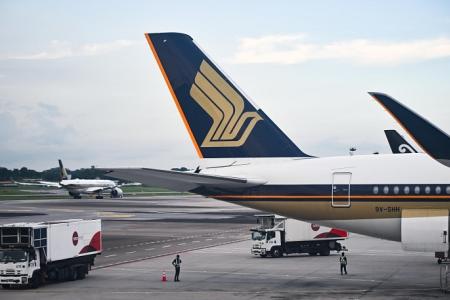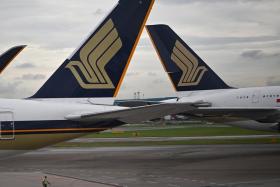SIA to continue expanding capacity
Despite intensifying competition putting a squeeze on its profitability, Singapore Airlines (SIA) intends to continue expanding its flight capacity, with chief executive Goh Choon Phong expressing optimism about growth opportunities in India and South-east Asia.
As rival airlines mounted more flights during the quarter ended Sept 30, the national carrier said it earned less for each passenger flown. This is because the injection of flight capacity outweighed the growth in traffic.
As a result, SIA Group’s net profit for the period between July and September plunged 59 per cent to $290 million, compared with $707 million a year ago. Apart from tapering revenue, the airline group’s costs also rose by 14.7 per cent over the period, with non-fuel expenses going up by 16.6 per cent on the back of inflationary pressures.
At a financial results briefing on Nov 11, SIA chief commercial officer Lee Lik Hsin said SIA’s passenger yields – a proxy for airfares – have declined across the board.
Revenue per passenger flown fell on all routes, and in all customer segments, whether in economy or business class. Going forward, SIA expects yields to continue moderating, Mr Lee added.
However, he emphasised that per-passenger revenues are still “healthily” above 2019 levels.
Mr Goh pointed out that yields for the full-service carrier in the second quarter of the 2024/2025 financial year were about 12 per cent higher than they were before the Covid-19 pandemic.
He also noted that while expenditures have risen, SIA’s unit costs, excluding fuel, have remained relatively flat, attributing this to efforts to keep costs under control.
Asked about the impending fee hikes at Changi Airport, SIA chief operations officer Tan Kai Ping said the increase in aircraft landing and parking charges will increase the group’s operating expenses.
But he noted that other airlines will be affected too. “(It) is akin to what happens if fuel price goes up. The whole industry will just adjust,” he added.
Commenting on SIA’s passenger load, Mr Goh said it remains strong and the airline expects demand to remain healthy. The group’s passenger load factor between March and September – a measure of the percentage of seats filled – came in at 86.4 per cent, down 2.4 per cent from the year before.
Mr Lee added: “We do not hold back on capacity growth just because there’s competition in the market... We intend to continue to grow.”
Hours after the briefing on Nov 11, SIA’s budget arm Scoot announced flights to three new destinations – Phu Quoc in Vietnam, Padang in Indonesia and Shantou in China. The low-cost carrier also said it will fly more often to Jakarta, Koh Samui, Davao and Vientiane.
Meanwhile, Indian carrier Vistara, which is co-owned by SIA, operated its last flights on Nov 11 ahead of a merger with Air India. SIA will retain a 25.1 per cent stake in the merged entity, allowing the Singapore carrier to participate directly in the growth of India’s aviation market.
The move by Scoot to expand its network was enabled by the delivery of new Embraer E190-E2 jets, with four of these smaller regional aircraft now part of the carrier’s fleet. One more is expected to arrive by March 2025.
However, supply chain snarls have hit other parts of SIA Group’s order book.
The group is now expecting five fewer aircraft to enter its stable by the end of the financial year ending March 2025. This is due to delivery delays affecting two of SIA’s Boeing 737 Max planes, two of Scoot’s Boeing 787-8s, and one of the budget carrier’s Airbus A320neos.
At the Nov 11 briefing, Mr Goh said SIA has taken steps to mitigate supply chain issues. These efforts include building up a local supply of spare parts, and tapping local facilities so repairs are done faster.
Asked about the delay to SIA’s upcoming 777-9 jets, which Boeing said in October will be delivered only from 2026, Mr Goh said the airline has always made plans for scenarios “that could potentially be worse”.
On Nov 4, SIA announced a $1.1 billion plan to retrofit its Airbus A350 long-haul fleet with newly designed first-class and business-class seats. The new seats were to have debuted on the 777-9s as early as 2021, but they have been held back by delays to Boeing’s next-generation plane.
Asked why the first retrofitted A350 would be ready only in 2026 and not earlier, Mr Goh pointed to a “very tedious certification process”.
While other airlines have also launched new cabin products in the past couple of years, SIA has been working to improve its new premium seats, he added. “We remain confident that the products we are introducing will continue to be industry-leading,” Mr Goh said.
Get The New Paper on your phone with the free TNP app. Download from the Apple App Store or Google Play Store now


